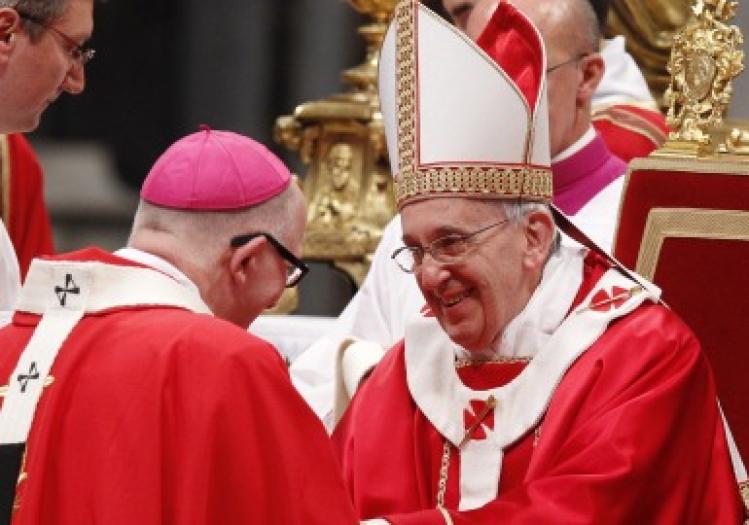
Pope Francis has taken a further step to bolster synodality and wean the universal Church from its unhealthy obsession with Vatican centralization. How has he done this? My colleague Gerald O’Connell, Rome correspondent at America, reports that Francis has pretty much killed the huge pallium ceremonies that John Paul II instituted early in his long, re-centralizing reign. And that’s not going to make the Ultramontanists or group travel agencies (i.e. pilgrimage organizers) the least bit happy. Up to now, metropolitan archbishops appointed in the previous year would come to Rome for the Feast of St. Peter and Paul (June 29) and the pope would place the woolen, Y-shaped ban over their heads and atop their shoulders at an ornate Mass held in St. Peter’s Basilica or the square outside. Some of the recipients, especially those from the United States, would be accompanied to Rome by a large group of faithful and benefactors from their new archdiocese – and not a few from the diocese they previously led. Some of these “pilgrimage groups” numbered several hundred people. Their time in Rome was marked by dinners, Masses at various basilicas and shrines, and even a banquet to honor their archbishop. A similar dynamic was also part and parcel of consistories when new cardinals are created until Pope Francis moved to tone down both ceremonies. As he did last year, he has again instructed the men who will get the red hat on February 14 to keep things simple. As for the conferral of the pallium, the pope has invited the recently named metropolitan archbishops to concelebrate Mass with him in Rome on June 29, after which he will hand them their pallium in a private moment. The actual conferral ceremony will take place “publicly and officially” at a later date in their archdioceses. The apostolic nuncio will do the honors in the presence of the suffragan bishops and the faithful.
****
The Catholic Church in the United States lost one of its best “popular” theologians and catechists last Sunday with the death of Fr. Richard McBrien. The Hartford, Connecticut, priest was seventy-eight. He had been in bad health the last few years, which – among other things – forced him to relinquish his prolific writing career. My best recollection of Dick McBrien is from a visit he made to Rome in January 2002. Fr. Keith Pecklers, a Jesuit teaching liturgy at the Gregorian University, was hosting the Notre Dame University professor. He approached John Allen, then National Catholic Reporter’s Rome correspondent, and me – just less than a year with The Tablet – to see if we would like to organize a gathering with journalists where McBrien would give a mini-lecture and engage in conversation. In the wide-ranging exchange he called for a “moratorium” on canonizations, criticizing John Paul II for planning to canonize that year Juan Diego, Padre Pio, and the Opus Dei founder, Josemaría Escrivá. He said these were not figures that ordinary Catholics, “most of whom are married with children and grandchildren,” could emulate. He also criticized the late Polish pope for allowing “partisans” to make the “soundly rejected” minority view at Vatican II the correct interpretation of the Council. McBrien praised John Paull II for his progressive views on social justice and relations with other faiths. But then he said, “I give John Paul II a generous D in domestic policy.” He was especially critical of his appointment of bishops, suggesting that he had unwisely alienated Catholic leaders who had legitimate but differing views from his own. Richard McBrien was the bane of the traditionalists and the retrodox. A Rome-educated priest and theologian, he sought to help people of our post-Vatican II age embrace the kernel of truth in the Catholic tradition, in all its beauty and all its sensibleness.
****
Dick McBrien, notwithstanding his call for a moratorium on saint-making some thirteen years ago, would be pleased with the latest list of people Pope Francis has pushed further along the track to official sainthood. Francis signed decrees recently to approve four new candidates for beatification and move seven others a step closer. And five of the eleven are lay people. Perhaps you’re thinking, “Big deal. That’s not even half.” But it is, by far, the largest percentage of lay individuals (this is excluding groups of martyr “companions”) that has ever figured into a batch of decrees signed on the same day. One of the four who will become “blessed” sometime in the coming months is a South African layman, Samuel Benedict Daswa. The pope signed a decree attesting that he had been killed “in hatred of the faith.” The convert to Catholicism, headmaster, and father of eight was stoned to death in February 1990 after standing up against the local customs of witchcraft and ritual killings. He will be South Africa’s first, officially declared martyr. Catholics in the Diocese of Tzaneen, in the northern part of the country, were anxiously awaiting this news. Now they are looking forward to the actual beatification ceremony sometime this year in their homeland. Among the other laypeople that Pope Francis put just one step away from beatification, pending a miracle through their intercession, was a man from Spain and women from Italy, Japan, and Bolivia. The Spaniard, Luigi Trelles y Noguerol, was the only other one (like Daswa) married with children. The other three, all women, were not married. So, while it is heartening that more lay people are being promoted to the “glory of the altars,” there is still a ways to go before the gallery of saints is more representative of the normal, everyday Catholic.


